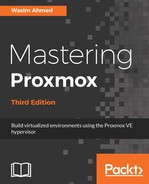Ceph is a distributed, highly scalable storage system which provides block, object, and file-based storage in the same storage cluster. Ceph is open source and designed to run on off the shelf commodity hardware. Currently, Ceph RADOS Block Device (RBD) block storage is fully supported by Proxmox. The Ceph Reliable Autonomic Distributed Object Store (RADOS) provides features such as replication, snapshot, and other block storage abilities. There are numerous reasons to consider Ceph as a storage backend. The following are some of the highlights of why one should consider Ceph over other storage systems:
- Ceph is free
- Ceph is a highly scalable, reliable, distributed storage system
- Ceph RBD is seamlessly integrated with Proxmox clusters
- Ceph can be managed and monitored through a dedicated Ceph menu in the Proxmox GUI
- Ceph can tolerate multiple simultaneous drive failures
- As the Ceph cluster grows in size, so does the performance
Visit the official link to learn about Ceph in detail if you are new to Ceph or want to know more about it: http://ceph.com/.
When compared to other storage systems, such as ZFS, GlusterFS, and so on, Ceph is a complex system. It requires extensive knowledge to properly maintain a Ceph cluster. Despite its complexity, Ceph also offers the highest level of redundancy spanned over multiple nodes and not just drive redundancy. In this chapter, we are going to learn how to install and configure Ceph to work with a Proxmox cluster.
